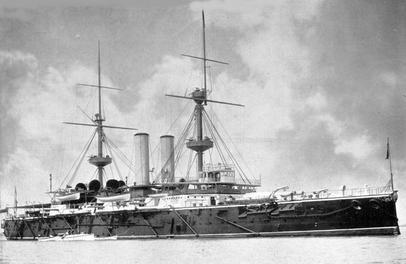February 07, 2020
What!?
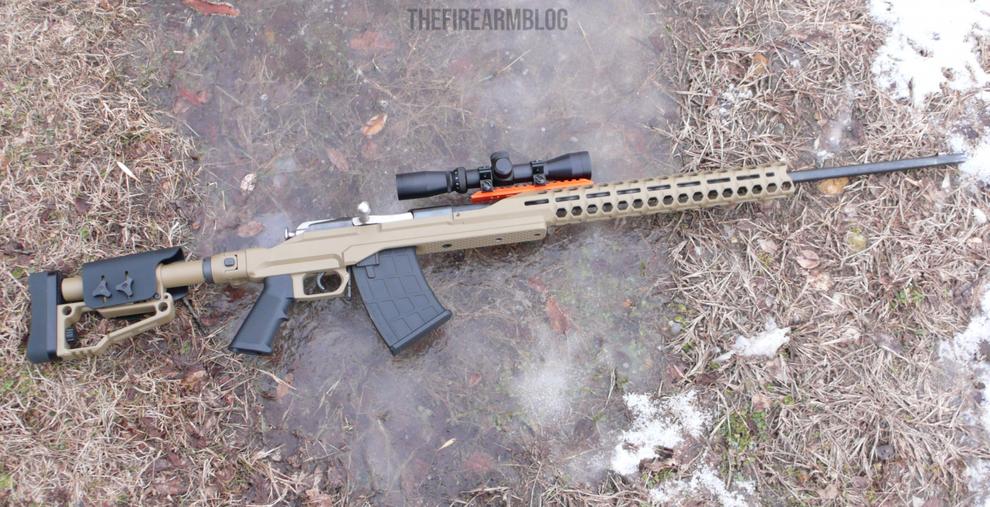
Yes boys and girls. That's a Mosin.
In a 450 dollar chassis with a $99. folding stock.
UPDATE: Upon reflection, this madness being from a Ukranian company, this might make sense in a place like the Ukraine, where, I imagine, the 3 Line Rifle is probably still cheaper than a used Hi-Point and....
...no.

Posted by: The Brickmuppet at
05:49 AM
| Comments (5)
| Add Comment
Post contains 56 words, total size 1 kb.
October 12, 2019
This month's U.S.Naval Institute Proceedings has an article (via) concerning the many advances in ocean sensing and breakneck progress in machine learning that have the potential to greatly reduce the ability of submarines to hide.
A broad range of emerging technologies is reducing the ocean’s opacity. Unmanned undersea vehicles offer cheap platforms for nanotechnology and 3-D-printed sensors and antisubmarine weapons. Machine learning and big-data tools enable the analysis of this data. At the same time, the proliferation of aerial drones and commercial satellite imagery allow improved intelligence collection on activity at submarine ports.
These technologies reinforce one another.....
The author, Zachary Kallenborn, suggests that this is not a transcendental threat to the survive-ability of the sea based portion of our nuclear triad, rather, he posits that increasing the capabilities of the submarine force will suffice. Gives specific examples of improvements that can help mitigate this threat.
He does not give specific examples of how to pay for these non-trivial increases in capability.
We are over 21 Trillion dollars in debt. Future budgets are going to be hit hard by austerity, and the severity, painfulness, length and societal risk of that austerity will increase non-linearly with every year that we don't engage in it. Because we are broke.
This is a thorny problem for a number of reasons. The biggest one is that the other legs of the triad are rather wobbly.
All 450 of our Minuteman ICBM silos are fixed sites. Their locations are well known to our enemies and at the top of their list of long worked out firing solutions.
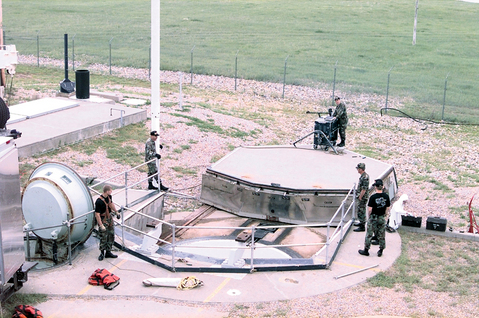
They make sense in the context of deterring a Russia limited by treaty to 1550 strategic nukes as each silo, as a matter of precaution will need about three warheads apiece, leaving all other strategic targets to be spread between the remaining the remaining 200 to be divided amongst ALL other military targets, leaving relatively few for the cities. Multiple warshots per silo are needed to account for duds or misfires, and to ensure a spot-on direct hit to ensure a kill. See, the Minuteman silos are impressively robust pieces of early '60s construction technology...
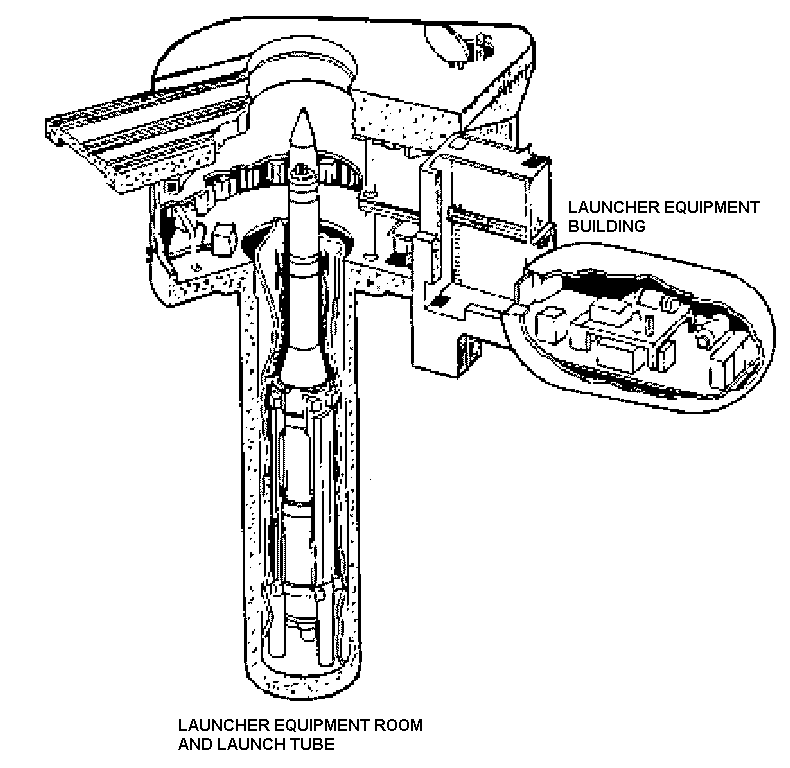
For one thing, targeting is vastly more accurate than it was in the '60s, meaning that direct hits are likely. More importantly, China, is not part of any arms control regime and despite being invited by the U.S. and R.F. have rebuffed any attempts to initiate the process of doing so. While the generally accepted estimates have China's nuclear arsenal being comparable to France's, if those assessments were way off, even by an order of magnitude no great surprise would be warranted.
So the math for these silos, dubious as it was, no longer works out.
Furthermore, the bomber force, as stealthy as it is, must operate from fixed bases, which also double as enemy firing solutions, and their stealth might be a transitory characteristic, as our friends the Germans have helpfully informed the world.
We need a strategic deterrent that is survivable. Currently, this is supplied by the Fleet Ballistic Missile Submarine Force, but as the Proceedings article above notes, that is a basket of some uncertainty in which to put our strategic eggs. Additionally, the whole point of having multiple delivery systems is to reduce the possibility that any one breakthrough renders our deterrent obsolete and our nation helpless.
There is a solution to this conundrum, and it's development costs are modest by virtue of it already having been successfully developed.
Just dust off the MGM-134.
What is the MGM-134 you ask?
It's an ICBM that was developed in the late 1980s and early '90s.
A little one!
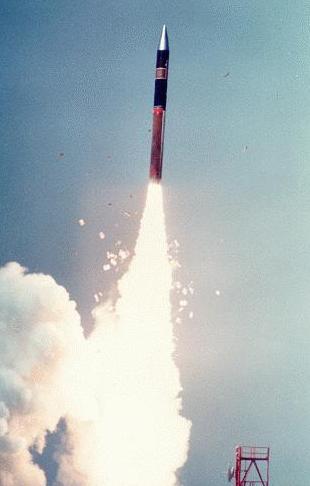
Whereas the big and now defunct MX-Peacekeeper-LGM-118 was developed as a Titan 2 replacement, the MGM-134 was intended to replace the Minuteman. Like the Peacekeeper, it was intended to be mobile, but that missile was intended to be moved around in huge, expensive, armored subways, (which were abandoned for cost-saving reasons and the missiles squeezed into old Minuteman silos during their 20 year service).
By contrast, the MGM-134 was far smaller, and was intended to be drawn around the country by an off-road, tracked truck in a self -burrowing armored capsule and be hidden in tunnels, barns, caves, haystacks, cornfields, warehouses, boxcars, forests, shipping containers, and perhaps even at the bottom of random lakes,. Moreover, they would be constantly moved around to make the enemy's firing solution nonexistent.
If this sounds silly, I refer you to the Great SCUD Hunt.
The name of this diminutive Minuteman replacement was MGM-134 Midgetman.

The missile was designed, successfully tested, and accepted for service, but it was cancelled with the collapse of the U.S.S.R. just as it was about to enter service.
It seems likely that ~400 mobile launchers, constantly moving around in a country this size, represents a far more survivable deterrent than 450 silos the targeting solutions to which are unchanging and well known. Presenting an enemy with a "SCUD hunt" a third the size of North America means they can never assure the destruction of the deterrent. It would make the survive-ability of the Ground Based Strategic Deterrent comparable to that of the SSBNs.
The Midgetman worked, it's developed, and 30 years on it still seems to meet requirements. Of course the erector launcher prototype was scrapped, but it might be better to use a new one anyway. It will fit into a 53 foot trailer and at 30,000 pounds, it's tare weight makes it usable on U.S. highways. meaning that that you could put some of them in Commercial Off The Shelf tractor trailer rigs painted up to be innocuous to move the things around. Targeting these things in the lower 48 states would be nigh impossible.
On the debit side, 30 years on, spinning up production is, of course, going to involve some changes and detail updates, but most of the design work is surely still usable. It achieves a range comparable to the current Minuteman by having a payload of only one warhead as opposed to the Minuteman's capacity for 3, but the Minuteman missile has been reduced to single warheads to comply with treaties anyway.
However, it should be noted that the other nations with Intercontinental Ballistic Missiles, Russia, China, and the DPRK all make heavy use of mobile launchers for them
This is an off the shelf solution to a real and pressing problem, and given its already existing nature, it ought to be a fairly economical solution.
Please check my math.
Posted by: The Brickmuppet at
03:12 PM
| No Comments
| Add Comment
Post contains 1151 words, total size 13 kb.
January 12, 2016
As we mentioned earlier, the North Korean government announced that they had successfully detonated a fusion warhead. Given the apparent small yield of the warhead, (6-10 kilotons) there has been considerable skepticism expressed. This skepticism is not unfounded especially given that getting such small yields are hard to get from what we normally think of as an H-bomb. There has been further speculation that the weapon is what is called a "boosted fission weapon". This does not get the majority of its explosive force from fusion, but it does set off a fusion reaction which causes the fission reaction to burn much more completely. This can as much as triple yields on fission warheads, or reduce the amount of fissionable material necessary for any given yield. This alone would be a big breakthrough as it would allow North Korea to make more bombs for the same amount of fissile material. An increase of 2 or 3 times the number of bombs in the arsenal is a very substantial benefit.
There’s some speculation that this is an attempted enhanced EMP weapon. There’s other speculation. Add to that that I have never worked in weapon design, and the last time I seriously needed to know about the minutia of nuclear weapons was more than thirty years ago, and you will understand that I am not going to speculate. We know that North Korea tested something, and they call it a sophisticated fission weapon; what they tested was low yield, and the last time I looked, low yield was harder to do than higher yields: particularly lower than 10 kt....[/quote]



Posted by: The Brickmuppet at
02:05 PM
| Comments (1)
| Add Comment
Post contains 1117 words, total size 9 kb.
October 29, 2014
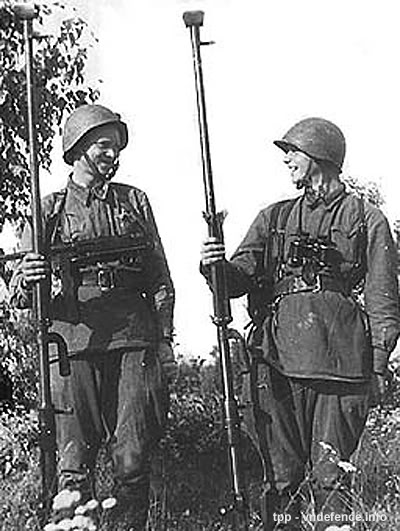 matching their 14.5mm anti-tank rifles against captured German tanks.
matching their 14.5mm anti-tank rifles against captured German tanks.
- Lower front plate (45 mm at 10 degrees): does not penetrate
- Turret rear (28-30 mm at 10 degrees): penetrates at 200 meters, 100 meters at a 30 degree angle
- Turret platform side (28-30 mm): penetrates at over 300 meters, 100 meters at a 30 degree angle
- Lower hull side (28-30 mm): penetrates at over 400 meters, 100 meters at a 30 degree angle

Posted by: The Brickmuppet at
07:59 PM
| Comments (7)
| Add Comment
Post contains 262 words, total size 3 kb.
April 07, 2013
Posted by: The Brickmuppet at
02:49 PM
| Comments (8)
| Add Comment
Post contains 12 words, total size 1 kb.
March 27, 2012
I blundered into information on Meriwether Lewis's air rifle.
The gun is important to U.S. history because it served to deter attacks
on the Lewis and Clarke expedition (they demonstrated it to the tribes
they met...and implied that they had quite a few more than they did). It
also reportedly took down a Grizzly bear at one point, though its
unclear how many shots this took.
I had known vaguely about the Austrian use of repeating air guns, but I had not realized just how impressive their performance was.

This is seriously impressive performance for 1790. Something like this would be a really cool survival gun today.
More here and info on the whole family of weapons can be found here here. The second link is particularly thorough and has this interesting tidbit as well.
Made in the 1940s during WW2, this gun doesn't look like a Girandoni, but examination shows that it clearly was built by someone familiar with the Girandoni repeating airgun system. Purchased in Europe, the story is that this gun was built somewhere in occupied Europe by a partisan bicycle maker during the Nazi occupation in WW2

Posted by: The Brickmuppet at
09:35 PM
| No Comments
| Add Comment
Post contains 246 words, total size 2 kb.
February 17, 2011
This takes 'Optimal Manning' to a whole new level.
I'm sure nothing whatsoever can go wrong.

Posted by: The Brickmuppet at
07:08 PM
| No Comments
| Add Comment
Post contains 20 words, total size 1 kb.
August 08, 2009
Over at The Marine Forum there is a very large collection of pictures from the 2008 Euronavale, a European defense contractor convention with a naval focus.
A few trends are visible, and others have commented upon some of them at length. The poster/photographer at MF was obviously drawn to the frontline ship offerings, in the distance there seem to be a lot of OPVs and similar vessels.
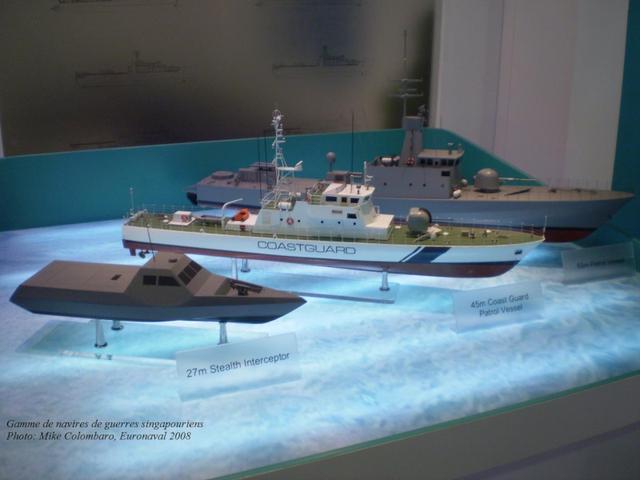

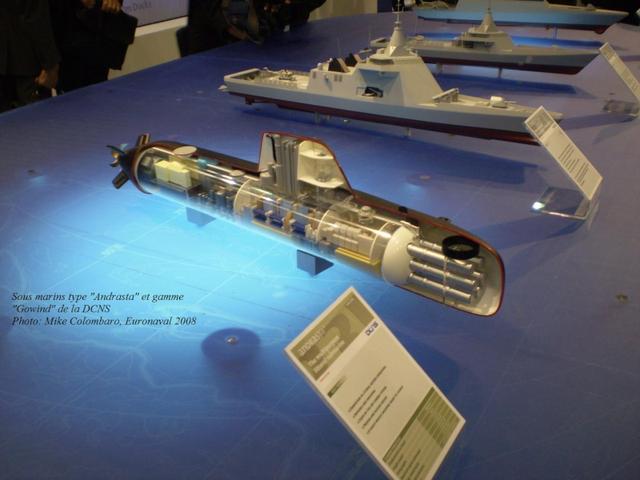
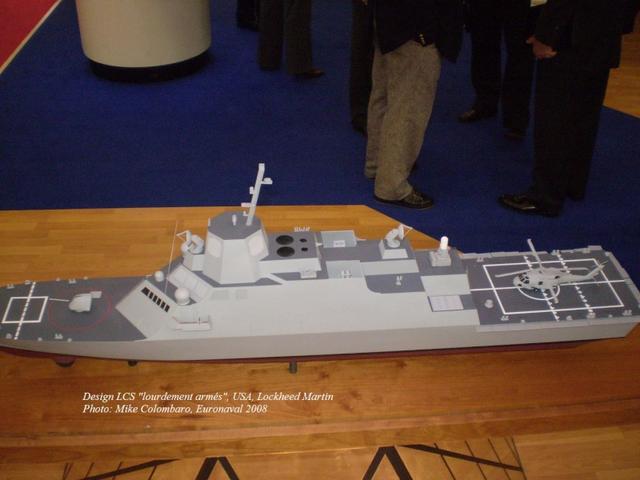
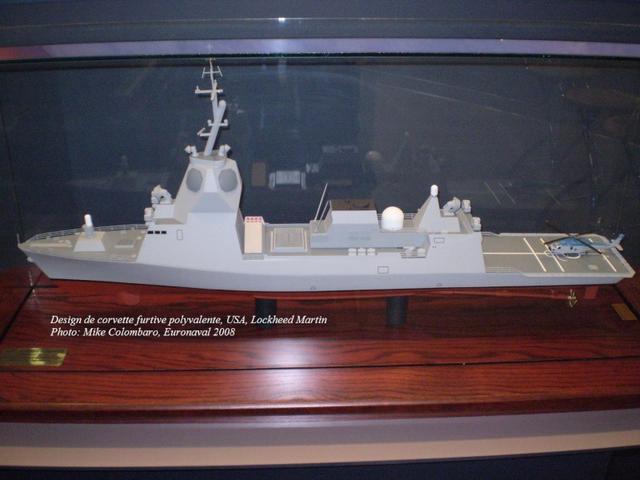
There are several export designs from US firms particularly LockMart which is not only offering yet another aegis equipped export version of their LCS (this time retaining the 57mm gun) but also an Aegis corvette that may be aimed at an Israeli requirement. Then there is this...
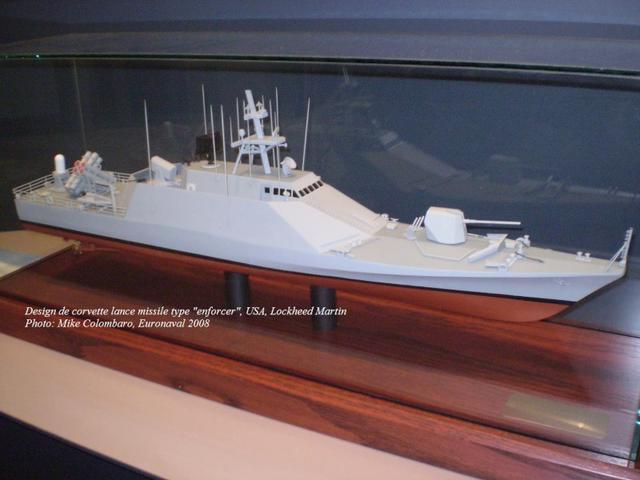
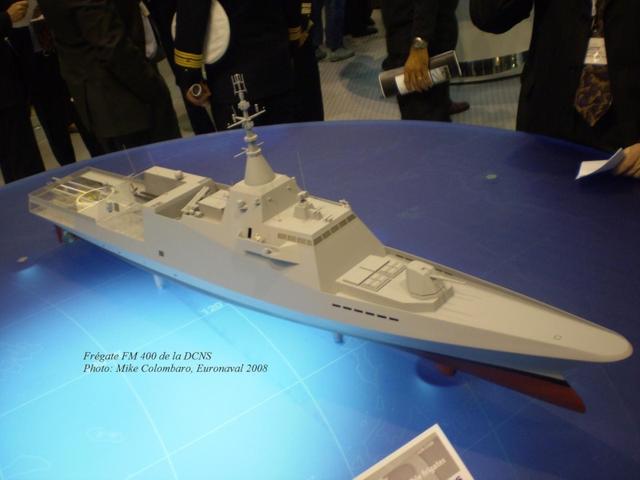
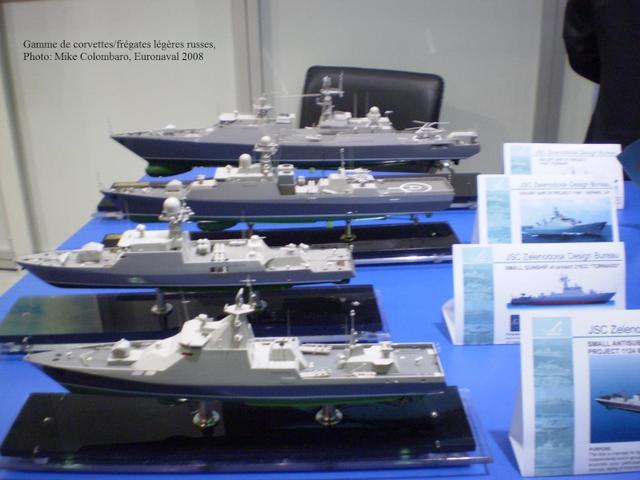
The natural predator of the small costal surface warship is an aircraft but SAMs might make this untenable in some circumstances. So the guns may be a hedge as well as being potentially usefull against small boat swarms,
One other thing needs to be mentioned, though it is not a trend...behold the solar powered Offshore Patrol Vessel (with force projection capability!)
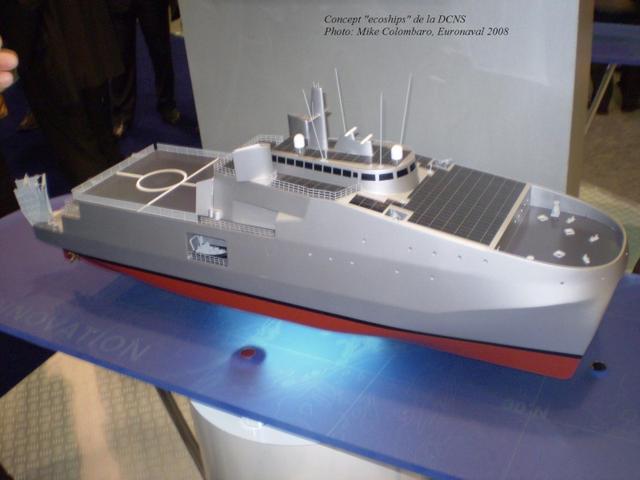
Anyway...discuss.
Posted by: The Brickmuppet at
04:16 PM
| No Comments
| Add Comment
Post contains 442 words, total size 4 kb.
July 14, 2009
Although there have been cost overruns and delays, the second of the competing designs for the Litorral Combat Ship has started sea trials.
Over at Information Dissemination, Galrhan provides the world with the first pics of the sea trials of LCS-2, which will be named USS Independence.
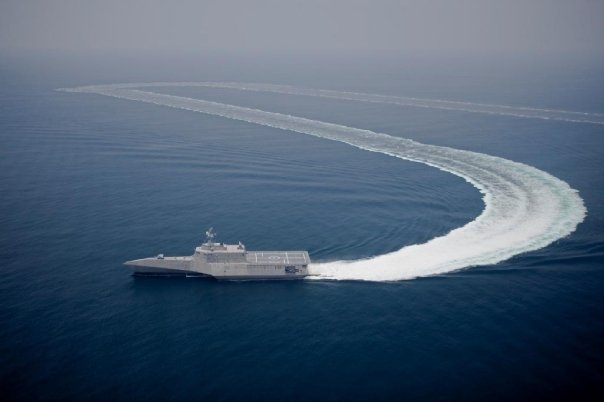
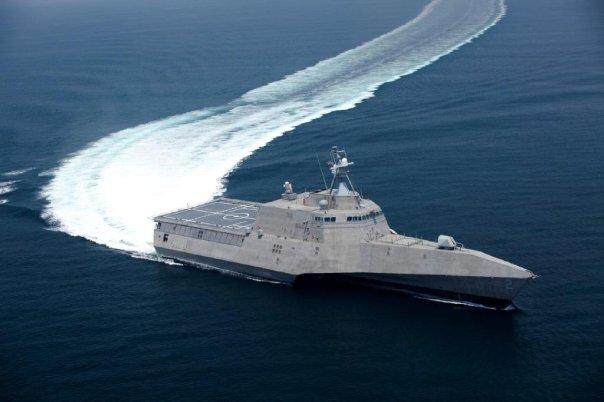
Good grief that thing is maneuverable!
One of the reasons this ship has hit so many time and budget snags may be that it was designed by Aussies, who are the world leaders in the trimaran hull form it uses and aluminum-smithing. I have heard that there was a very steep learning curve for the US Yard in these areas. This is a riskier design and it pushes US shipbuilding to the limit, but I strongly suspect this design will be more stable at all speeds and most sea-states than the Locheed Martin designed LCS1. It ought to have more room for growth and be more fuel efficient too, all other things being equal (which they may well not be).
As always there is a highly informed and interesting discussion in the comments of this post over at Information Dissemination. If this sort of thing interests you, then you should be stopping by there every day.
UPDATE: Gahlran has a bunch of gorgeous high res pictures of the trials.
Posted by: The Brickmuppet at
09:12 PM
| Comments (2)
| Add Comment
Post contains 232 words, total size 2 kb.
July 13, 2009
January 29 2009 was a dark day for the US Navy.
On that date the last active squadron of S-3 Vikings, once one of the USN's primary antisubmarine aircraft was retired. It does not currently have a replacement, which is a cause for some concern. This happens as the main surface ASW platform, the Oliver Hazard Perry class frigates are nearing the end of their useful lives. As the last of those go, the helicopters that operated off their decks go away. The Destroyers with helicopter assets are not very numerous and in any event as they are effectively combination battleships and anti air pickets..... and ABM platforms....are likely to be stretched thin with their other duties. This unhappy state of affairs coincides with an explosion of the number and effectiveness of diesel boats in the worlds submarine forces.
Worse still, is the fact that the USN is saddled with a broken procurement system. Ships and even planes can now take years if not DECADES to reach operational capacity. This will take years to fix. Thus any replacement aircraft that are to be acquired quickly and cheaply must be more or less off the shelf, preferably Commercial off the shelf...unfortunately there just is no carrier capable aircraft sitting on a shelf right now.
Topping off this perfect storm of grief is the current financial crisis which is only going to get worse in the near term and the horrific debt the US has incured in the last few months that threatens to bankrupt us...thus any replacement MUST be relatively cheap.
It would be unwise to postpone such a program.
The Second World War experiences of the US and Britain in the Atlantic and Japan in the Pacific demonstrated the price a nation can face when antisubmarine warfare is put on the back burner. Japan did not survive. Its ASW was an afterthought and the island nation was cut off from supplies of both food and industrial materials. Its navy instead put a huge ammount of their maritime industrial bandwidth into building comparitively small numbers of huge, expensive ships that were designed to be qualitatively superior to their foes....and which now litter the Pacific seafloor.
The US and the UK did beat the submarine menace in no small part because at the UK's urging the United States built over 100 escort carriers thanks to its massive industrial capacity...a capacity that has deteriorated. Now to a large extent such capacity exists only in....China.
That is, therefore, a lesson that is non-applicable in the short term.
There was one other interesting and generally unsung weapon that was unique to the USN in WW2. It may fit the requirements of cheap, off the shelf and effective airborne antisubmarine assets.
Dirigibles like the K class airship were astonishingly effective.
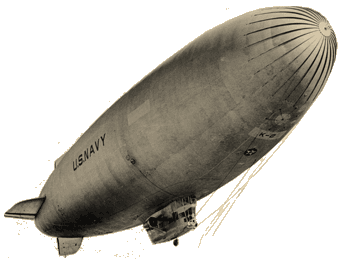
After the war airships of improved types served as antisubmarine craft, and, increasingly, in the airborne early warning role. In the early 1960's, as part of a larger overall policy of making bad descisions, Robert MacNamera oversaw the dismantling of the Navy airship program. A few years later, it was discovered that hovering and being able to dunk sonars were very useful ASW traits and helicopters were pressed into service as ASW platforms.
Now the lack of any naval blimps today might make one think that there is no way to get this off the shelf. That is not necessarily the case.
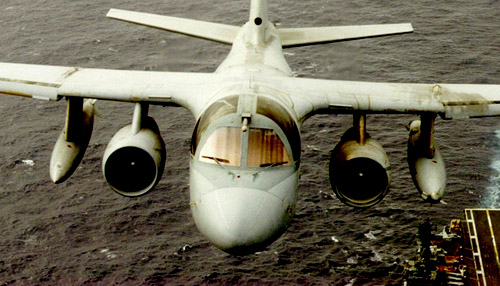
The Zeppelin NT, a rigid airship has a useful payload of about 4100 pounds, so we are in the ballpark. Note though that sensors, like a good radar and a magnetic anomaly detection boom will eat into this, not to mention crew quarters.
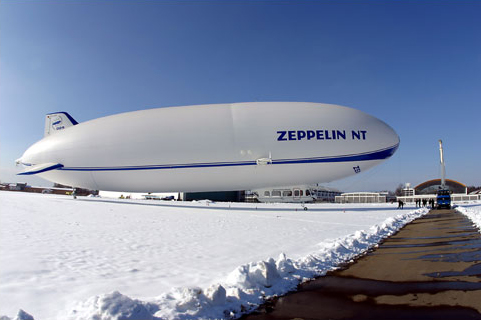
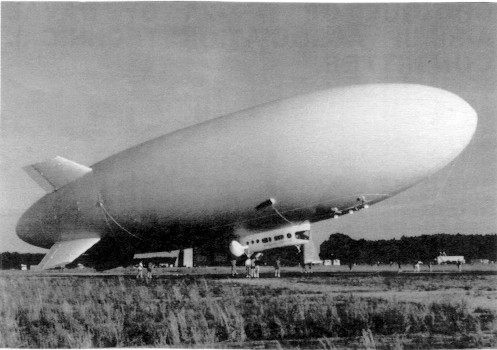
Endurance of most off the shelf designs would be low, between 12 hours and two days , but they would have far more loiter time than a helicopter or even the Viking they replace. They could replenish at sea vertically like a helicopter to extend their range. Larger airships could be developed incrementally with lessons learned and applied in small construction batches. All of these are smaller than the frontline airships the Navy was operating in the 1950's, so in a few years we could incrementally build up at least to that capability.
Airships are not perfect. Because of their large sail area they have difficulty handling typhoons, or hurricanes and they tend to react badly to nuclear ordinance...
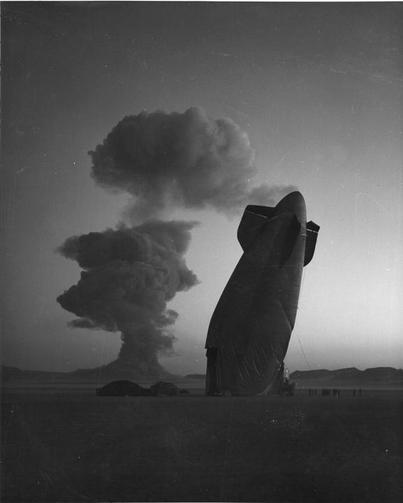
Click here for supahsize
This post would not be complete without a brief mention of Aereons, hybrid airships and other developments of the airship concept that promise far greater performance...and have been promising since the early sixties....but have gotten no results. Military Airships is a very comprehensive site dedicated to these craft and Darrell Campbell is quite an ardent and eloquent proponent of their capabilities. His arguments are valid up to a point, namely that the hybrid airship he advocates have vastly greater potential than regular blimps. Specifically these designs combine a lifting body airframe and modern materials to greatly increase performance. However, while the tech is not unsound, it only works on very large ships and, more importantly it is, not mature technology. It will require considerable integration efforts as well as trial and error. These take time and money that we don't have. Rather than letting the best be the enemy of the good, it seems prudent to me to go with what we have and develop the ideal capability through trial and error.
There are many promising technologies that might aid us in hunting submarines, USV swarms, or small craft with dipping sonars using sprint and drift tactics for instance. But the good old blimp is here now, has a proven track record and might be had rather economically. It certainly warrants a look.
Posted by: The Brickmuppet at
03:12 PM
| Comments (3)
| Add Comment
Post contains 1116 words, total size 9 kb.
June 09, 2009
When commissioned in 1890, HMS Victoria was one of the most powerful ships in the world. A test bed for several new technologies she nevertheless represented in some ways a technological and tactical dead end being intended to fight end on with an eye towards ramming. To that end her main armament was concentrated forward and consisted of two huge experimental 16.25 inch guns in a massive armored Coles turret. There was also a very heavy secondary armament of 6 inch and smaller weapons as well as some torpedo tubes. Finally there was a massive armored ram below the waterline. All that armor and armament forward on a 10,000 ton ship meant that freeboard was low at the bow and the ship was considered best suited to the Mediterranean squadron. She was very well equipped as a flagship however and as such bore Admiral George Tryon's flag on 22 June 1893 when, off the coast of Syria, the Mediterranean fleet was engaged in maneuvers.
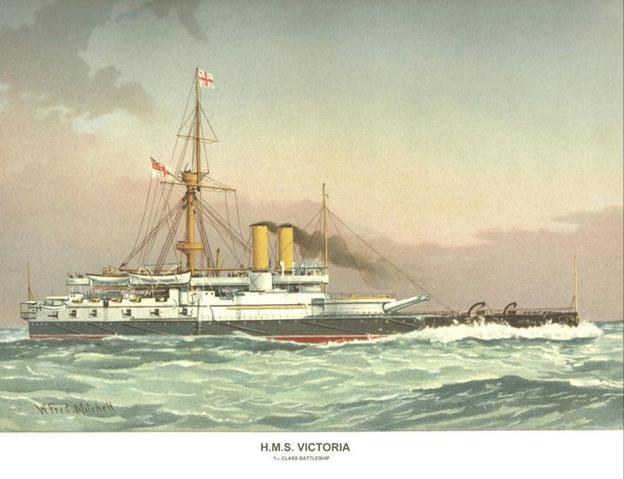
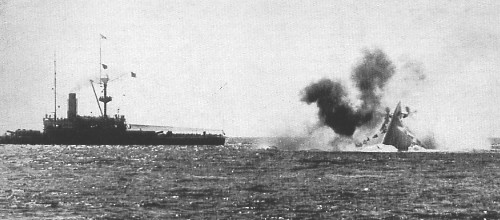
Posted by: The Brickmuppet at
10:13 PM
| No Comments
| Add Comment
Post contains 281 words, total size 2 kb.
May 03, 2009
A Japanese destroyer.
There is no such thing as a Japanese aircraft carrier...
Nothing to see here move along.
Posted by: The Brickmuppet at
08:32 PM
| Comments (7)
| Add Comment
Post contains 26 words, total size 1 kb.
March 22, 2009
As has been mentioned here before, the combination of increasing unit costs, aging hulls in need of replacement an increase in the numbers of units needed and the unforced budget debacle facing the treasury has created a procurement conundrum for the US Navy and Coast Guard.
We need ships, lots of ships in a decade or less but given the economy we are likely to have have very little money
Given the high tempo 'medical diplomacy' operations pioneered by the Bush administration as well as the need to respond to disasters such as typhoons, volcanoes, plagues and tsunamis at least some of the vessels we build ought to have some sort of cargo capacity and a larger than average medical facility.
A converted or redesigned merchant design would seem to be the logical choice but if these are to replace the FFGs then it is important to ensure that such a vessel be capable of providing something in the event of a hot war other than terrible ways for bluejackets to die.
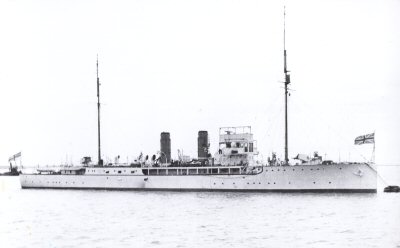
The challenges of modern warfare mean that an electronics fit is needed of course so such a ship will bear no relation in cost to whatever merchant ship it is designed from, but it might cost something akin to a modern corvette.
Lets take a standard American containership design, the Philidelphia Class, and assume the aft deck is used for helicopter operation and the aft holds are used as a flex deck for small craft and Littoral combat ship modules. The holds forward of the bridge have ample room for containers that can contain everything from food to hospital or war supplies. I'd use the midships below decks space (where pitching would be minimized )for a big hospital and a secondary helipad (if only to directly service the hospital). This would not have the capability of the Mercy or Comfort but it could conceivably approach that of the LHAs and could do a LOT of good on mercy missions.
It might be less threatening as well. Note that while such a vessel would not be a hospital ship, and would therefore be targetable by law, most people we are likely to lock horns with are unpersuaded by appeals to human decency anyway. Forward of the hospital area, even 2-400 containers would be an impressive ammount of relief supplies in peacetime and still leave room for 16-32 VLS cells for ESSM. The large helideck would give a decent helicopter borne ASW and possibly even minesweeping capability in wartime especially if during a major war something like SCADS or the old ARAPAHO concept were put into place along the lines of this....
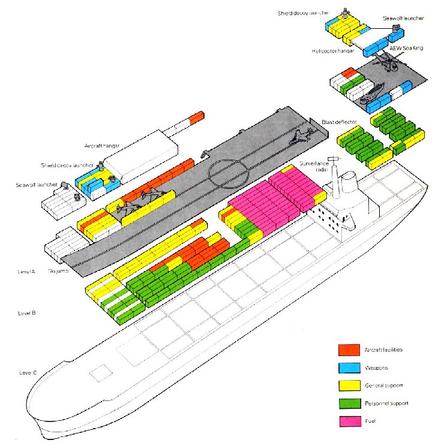
These would probably not able to be procured in the same numbers that 600 ton corvettes might but they could ad a considerable complementary capability to the low end of the hi/lo mix.
At any rate it may bear considering. Any thoughts?
UPDATE: In the comments James Rummel takes the time to comment at length about the idea and makes some lucid points but also indicates that I may have been unclear about as few things.
These are not replacemtnts for our cruisers and destroyers, but a low end complement. If they replace anything they might best replace part of the production run of the LCS vessels....
IF they can be procured more economically and IF they would be a net improvement in capability . These are indeed big "IFs".
There are certainly all sorts of issues with this concept both political and practical. However, I am of the opinion that, if built, these would be warships with peacetime duties similar to a 19th century gunboat but with much greater utility to assist the main force.
Mr Rummel makes another comment that deserves mention.
You suggest that this is only a temporary change until economic conditions improve. But anyone interested in military procurement will tell you in a heartbeat that it would be almost impossible to get Congress to pony up for actual, very expensive warships after a decade of building cheaper cargo ships. Once the change is made, there is no going back.
This is a very real concern.
It is probably one reason the navy doesn't build some smaller carriers to increase survivability through numbers. This was tried in the 70s ant the congress made it plain that it would ONLY buy the smaller carriers and not increase numbers...thereby gutting the navy but giving the impression that congress was providing modern ships.
It does not always work out that way though.
In the 1880's the UKs shipbuilding program was terribly screwed up, with problems that included cost overruns, excessively long build times, ships massively over budget as well as overdue, quality control issues, problems integrating new technologies and simple corruption (sound familiar?). The response was to, for a time, order only second line vessels such as gunboats and auxiliaries as well as a few experimental technology test beds such as experimental high speed craft (the torpedo boats).
These were often ordered outside the usual defense procurement clique.
In the meantime the procurement system was overhauled, investment was made in physical plant improvements at the shipyards and the procurement system was reformed, Concurrently, a determination of what sort of vessels were needed was made. Then rational, attainable requirements for the various types of vessels were drawn up that matched the then current technologies, the national strategy of the time as well as the gamut of potential scenarios.
After several years of building gunboats and finishing the dubious vessels that were already ordered, the Royal Navy began building ships under the Naval Defence Act. William Whites design team produced the finest ships that had been built up to that time and for nearly two decades, every subsequent class was an improvement on their design predecessor in some way.
From that point until WW1 the British Royal Navy built a balanced fleet and produced some of the best, most economical; and cost effective ships of their day.
So while the pitfall Mr Rummel points out is very real, it can in fact be avoided if care is taken and the legislature acts in good faith...another very big "IF".
Posted by: The Brickmuppet at
12:00 AM
| Comments (10)
| Add Comment
Post contains 1172 words, total size 8 kb.
March 07, 2009
Colleen Doran laments the disappearance into the publishers aether of the last of the "Big Books" the Big Book of Wild Women which would have featured a story illustrated by Ms. Doran about the warrior queen of the Celts. In fact she laments its disappearance so much that she went ahead and published her story as part of a long, informative post concerning the historical Boudica.
Anyway, read the whole thing.
Posted by: The Brickmuppet at
11:31 PM
| No Comments
| Add Comment
Post contains 78 words, total size 1 kb.
February 22, 2009
So what sort of ships should we be building the Navy, Coast Guard and Army Transport command to meet their future challenges?
This has been a point of interest on this blog off and on for some time, but the circumstances we are in and the challenges we face have both changed for the worse in the last month.
While I think the Bush administration gets a bit of a bum rap on many things, one area where they certainly did not cover themselves in glory is in the realm of military procurement, particularly on the shipbuilding front. Focused on the various awful conundrums and unpalatable choices the administration was presented with, they chose to leave the shipbuilding policies virtually rudderless in shoalwaters for 8 years, with the predictable result that the surface shipbuilding program is now on the rocks.
This is exacerbated by the fact that the US is in a rapidly deepening financial crisis. With the US having the worst January since the Panic of '96 (That's 1896 btw). Whatever optimism about a short recovery period there may have been dashed...just as we are now saddled with an ill-conceived orgy of spending that will stretch our budget terribly, the challenges facing the current administration in this area are considerable. Money is tight, so tight that the repairs to a cruiser after a recent grounding may affect the preventive maintenance of many other ships.
But wait! There's more! The development of the EMALS catapult system is reportedly in doubt this actually jeopardizes the whole carrier program right now. Other new ships are massively over budget and riddled with quality control problems. The congress wants to saddle the Navy with insanely expensive nuclear escorts that not only cannot be built in any numbers in the best of times, but are problematic from public relations and diplomatic standpoint, as they have a difficult time doing goodwill port calls as they will likely attract luddite green protesters like flies.
All this adds up to the fact that the most vexing questions facing the military may well be not what ought we to be buying...but what can we afford?
We may have to cease carrier procurement for a decade if the 25% defense budget cut desired by many in congress is passed. Hell, destroyers may be off the table too (though that is not as big an issue near term as we have quite a few first class underage units).
Minesweeping, antisubmarine warfare, inshore work, antipiracy operations as well as various subsidiary duties are currently slated to be performed by the Littoral Combat Ships. These ships are designed to be fast, and are fitted to take a mission pack dedicated to whatever mission the ship is assigned at any one time. This was intended to make them cheap enough that a large number (70+) could be bought.
Unfortunately, the new kit cost a lot to develop and the hulls, designed for speeds approaching 50 knots (!?) require very high levels of skill to manufacture. One result is that they cost 450 million apiece with the modules to provide their "teeth" still under development (all that innovative cost-savings doesn't come cheap). They are interesting vessels, not without utility, but they are probably too expensive to acquire in the numbers needed.
Those numbers are not entirely clear but they are fairly large, as all of these procurement calamities coincide with a vast expansion of the number of submarines being operated by nations more or less unfriendly to the US, plus a worldwide increase in piracy as well as an international situation which places a premium on soft power efforts such as disaster relief, "showing the flag" and operations like Continuing Promise and Pacific Partnership....the high tempo humanitarian/diplomacy operations pioneered by the Bush administration .
All of this requires a large number of ships...just as our budget is busted. With many of our vessels at the end of their lives, speed is also of the essence, so it is probably not a good idea to start designing a vessel from scratch or fitting it with groundbreaking technologies.
There seem to be two schools of though amongst navy types as to what sort of vessel we need.
One school advocates something akin to a small frigate, another, a fast attack craft 5-600 tons.
A proposal like the latter (inexplicably called Streetfighter) was the genesis of the Littoral Combat Ship, which, as mentioned, grew in both size and expense.What the FAC/Corvette advocates there fore are proposing is to do the LCS program again, but apply the lessons learned to get it right this time. The benefits perceived are as follows...
To be affordable in numbers, any vessel of this size will likely have to be given a rather more austere fit of weapons and sensors....which it is argued, should be fine for peacetime gunboat duties. If a helicopter hangar is not considered a necessity (a dubious notion IMHO) there have been numerous FAC designs from various countries over the years.
Italy in particular produced a family of light attack and patrol craft for export in the 70's and 80s of which the Ecuadoran Esmereldas , the high end of the series, is probably the most well known.
The ones presented here were never built but are included because all three are fairly austere but potentially useful.

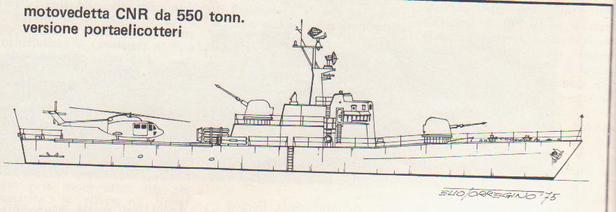
The rather precarious helicopter deck in the third design could just as easily be filled with ISO containers full of, relief supplies,some of the minesweeping or ASW modules intended for the LCS or....hospitals.
These are all 25-30 year old designs but still give a ballpark idea of what can be done on 5-600 tons.
The problem with this is that these 5-600 ton designs seem lightly equipped in comparison with their counterparts, particularly their Ecuadoran half sisters. This line of reasoning can lead to diminishing returns.
The temptation to add "stuff" is strong. AAA missiles are nice to have and some sort of antiship punch seems silly not to include. Also, a helicopter hangar is high on the want list. This line of thought can easily bring us to what is probably the most extensively equipped FAC design right now, the French Combattante BR 70 and BR71 (article in French but also see here).
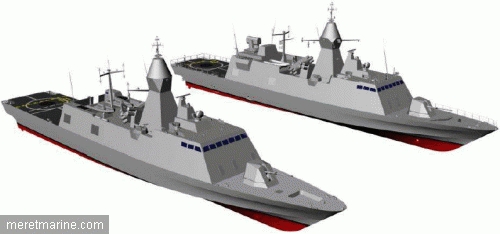
Finally, putting all these systems on a small hull is unlikely to involve any significant cost savings over a frigate sized vessel. The hull is the cheapest part of a warship. The missiles, fire control, C4I, ECM and ECCM systems all cost a lot and getting them to work on a small hull is problematic due both to having antennae mounted close together and the fact that a small hull pitches more. There are certain navies whose needs are met by such a tight design particularly if they use (like Sweden does) armored docking facilities, but for us, especially given the forced financial parsimony we face its probably better to go with a frigate sized vessel perhaps acting as a "leader"to carry helicopters and more elaborate systems.
One option is to modernize the remaining Oliver Hazzard Perry class, perhaps along the lines of the Australian's upgrade. This is potentially troublesome as the Perry's have been run very hard and likely have microcracks and other difficult to repair wear and tear. Also, the Australian upgrade has not been without problems, but at least the lessons have been learned. If an upgrade and refurbishment can be done cheaply then the vessels could have their life extended a decade or so which might get us over the financial hump. Reinstalling the MK 13 launcher would give the ability to 40 or so land attack versions of Harpoon and ESSM would take care of the AAA requirement.
As for new build frigates any such construction must have economies ferociously enforced as was done with the Perry (FFG7) class. Happily, there is actually a US design that is viewed favorably and while it has had some minor problems these have already been found out and are being fixed*. The Coast Guards National Security Cutter is extraordinarily seaworthy, reasonably fast and has very good helicopter facilities. It is lightly armed but there appears to be a space reserved for a VLS or something behind the 57mm gun....Put a VLS nest there. A 16 cell unit would look to be the maximum. That gives you 32 ESSM and 8 ASROC or 64 ESSM. As for sensors, on the high end, fit SPY1-K (an austere export version of AEGIS). Bolt on HARPOON or PENGUIN to taste.
Fit a towed array sonar in the area used for boat handling aft or modify it to a working deck for handling various mission kits and supplying the aforementioned little gunboats.
Fit as hull sonar a development of the same sets on the old FFG7's or refurbished FFG7 sets.
You then have a low end but still capable replacement for the FFG7s with more capability than they ever had.
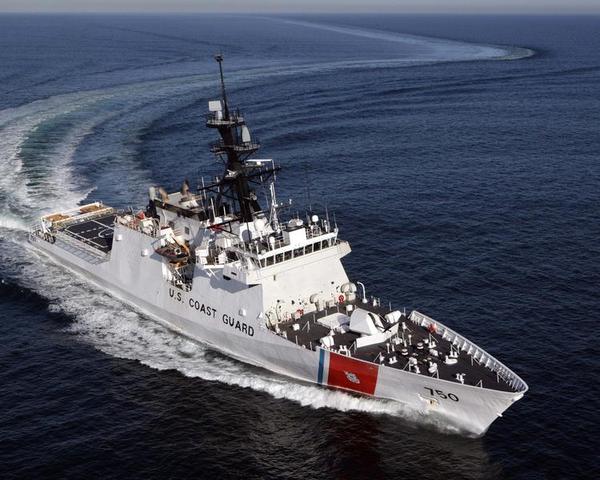
And they'd be prettier too...even if they were grey.
Another even less expensive option for frigate/corvette sized vessels is to have the Navy involved in the design of the more austere **Offshore Patrol Cutters and, perhaps, subsidize their cost the way they did the old 110' cutters, possibly buying more than 25 of them. This might involve adding some shops and underway replenishment capability to tend smaller cutters and the modern version of the gunboats mentioned above. Pirate fighting as well as many 'short of war' activities are a good fit for the Coast Guard (as has been mentioned here before).
Having the operational replacements for the Perrys current duties manned by the USCG would free their rather large crews for less subsidiary duties and ensure that bare bones Offshore Patrol Vessels not be counted on the navy list as full frigates or destroyers as some congresscritter would be tempted to do.
There are larger systemic issues involving the expense of getting things built in US shipyards that range from the cost-plus contracting system to limited competetion. These are topics for another post, but one potential benefit of the small 5-800 ton vessels is that they might be built in many more shipyards, thereby encouraging some competition and further cost savings.
There is a lot of stuff we can't afford in the near future, but if we avoid letting the best be the enemy of the good we can likely muddle through this period without loosing to much capability.
At least I hope so....
*The 2 main issues that the cutters have had both were rather overblown and I am ashamed to admit that I fell for the hype.As I understand it now, the issues stemmed from the fact that the Coast Guard changed the requirements after construction had started. First they went to a multi crew arangement so the cutter could stay at sea much more often....which consequently increased wear and tear and reduced maintenance time. This meant that the fairly extreme 30 year lifespan might not be achievable with the original design. Subsequent cutters are being built with reinforced scantlings and the lead ship will be refitted in due course. The ship is currently sound structurally...the newer ones will be better. The other issue involves the fact that TEMPEST grade electronics were fitted to a vessel not initially designed for it. Bertolf's comm systems are as good or better than any other cutter save perhaps the ex navy PC's. Subsequent vessels will be built to TEMPEST standards. There is more on that here....money quote
TEMPEST is the most overrated problem in modern defense spending history, and it isn't close... and the facts prove it.
** A post from last year on the OPC is here.
Posted by: The Brickmuppet at
01:00 AM
| Comments (2)
| Add Comment
Post contains 2176 words, total size 17 kb.
January 04, 2009
Over at Information Dissemination, Galrahn is tilting at the windmill of misleading nomenclature. It seems that some in the USN are determined to have everyone believe hat the Littoral Combat Ship...that 3,000 ton speedboat with the armament of a Coast Guard cutter...the one that is intended to act as a tender in time of war...is a Frigate.
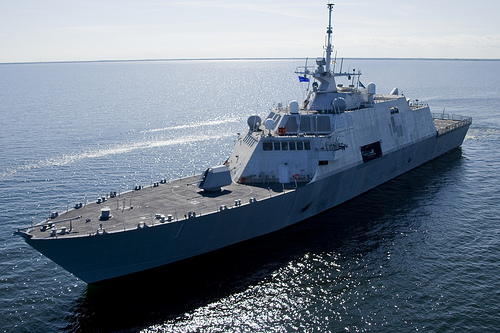
Words like warship and frigate matter, when the LCS is sold as a frigate or as a warship, it carries with the name an expectation the ship is best used as a warship or frigate. The LCS is neither best used or even well used as either. A modern warship that does not carry a single kill weapon of any kind is not a warship, and if the ship is intended to be used in theaters of war then it does so only as a support ship when it brings no offensive tactical capabilities during wartime. The function of the LCS is support, the tactical principles are exclusive to roles of scouting and C2, by every tactical metric as constructed and in CONOP when explained, the LCS is a support ship, not a warship. The intent to explain, describe, or sell the LCS as a warship is dangerous, dishonest, and deceitful.
The last sentence might seem an over the top reaction to what seems to a layman a simple bureaucratic nomenclature fight. However it is entirely correct when one is aware of the history and implications of misrating warships.
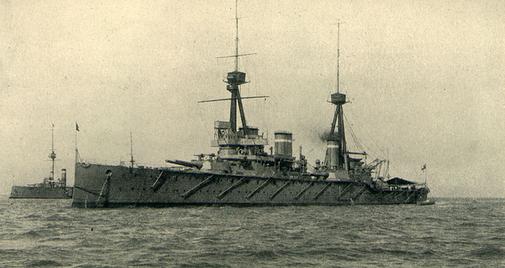
Although not entirely applicable to this problem the story of the UK's battlecruisers is illustrative. In the early 1900's the UK built a series of big, very fast cruisers with battleship caliber guns intended to scout ahead of the battleline and overwhelm more conventional cruisers and commerce raiders. They were armored like the preceding armored cruiser classes and had cruiser strength scantlings. The big guns were intended to outrange other cruisers and provide a means to fire back on scouting duties while they hightailed it from the sort of close combat they were not intended to meet. For domestic political reasons, they were, around 1911, designated BATTLE cruisers and the term "capital ship" was coined to give the impression that they were part of the battle fleet...thereby giving the impression to the public that the Royal Navy had more battleships than it really did. During WW1 they were thrown into the battle line at Jutland so their heavy cannons would not "go to waste"...with the result that 3 were sunk in quick succession with the loss of all but 30 of 3300 crew between them.
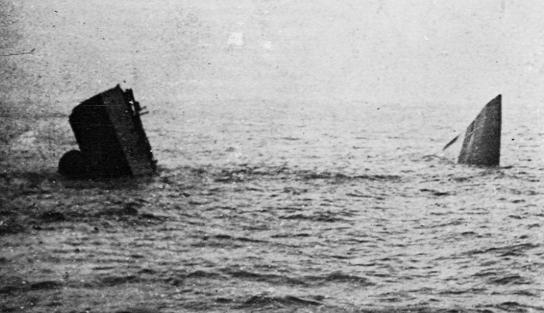
Like the battlecruisers, the Littoral Combat ship is built to less stringent structural standards than other frontline ships, and like them it seems to be a very expensive solution to the problem it is intended to tackle.
However, it gets worse than that, because there is a major difference between the two types of ship.
Battlecruisers carried big guns and could (and did) damage the enemy. Invincibles career was quite distinguished right up to her loss. HMS Renown and Japans (British designed) BC's gave a good account of themselves in the second world war. Although vulnerable to fire, they packed a punch (Churchill called them "...eggshells armed with hammers"). The LCS has a 57mm gun, some machine guns and, if the NLOS missile is not cancelled, some light guided artilery rockets (NLOS is basically a long range Hellfire). The remote vehicles it is supposed to carry have no ship killing weapon. Its most powerful ordinance will be carried by its 2 helicopters. It is potentially a very useful support vessel and can complement the capabilities of frontline ships, but it is fragile and can't fight. In a hot war LCS is an eggshell armed with toothpicks and a multi-tool, fighting a bowling ball.
Galrhan is right, the vessel is certainly not a frigate. And this is an important distinction for reasons beyond it's vulnerability. Unlike the Battlecruisers, which brought battleship guns to the table, the LCS brings basically nothing to the frontline at all save an additional target (and a fragile one at that) Because of its lack of any serious weapons, no admiral is going to be inclined to use it as a combat asset because it can't add anything except perhaps electronic warfare capability. No, the danger for the navy is that CONGRESS decides that these vessels represent actual warships and orders them IN LIEU of more warships....which might leave an admiral with nothing else to send.
To a congresscritter, especially the sort of congresscritters we have in the majority now, calling the LCS a "frigate" is the same as saying its a destroyer escort. To them this makes requests for actual warships redundant. They would rather spend money on almost anything else and this nomenclature gambit gives them an out.
This is not to say the vessel is worthless necessarily....
It's capabilities are indeed useful and are well in line with a gunboat or "peace cruiser".
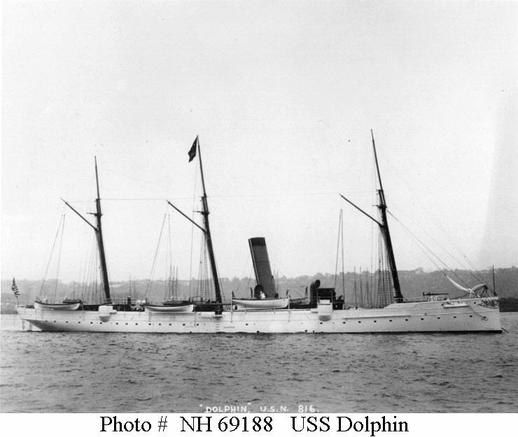
While the USN's naming scheme for capital ships is haywire at the moment, it is clear from the naming convention announced for the the LCS (they are named after small towns...just like most of the old PGs and peace cruisers) that the Navy considers them basically Patrol Gunboats in function.
With their huge flex decks an impressive helicopter decks, these vessels can do the soft power activities like disaster relief and possibly even low end hospital ship missions and such. Like the old gunboats these could be useful auxiliaries in a hot war, being used as ROV support and mine countermeasures ships much as the old gunboats tended to be used as tenders and minesweepers....the big difference is that that capability is built into them from the start.
If there is a gripe about the LCS aside from those trying to classify it as a frigate, it is that they seem to be a very expensive solution to the problem. Better, more robust and versatile results might be obtained with an actual frigate but with a flex deck, something superficially along the lines of Denmarks Absalon class but with 4 rather than 2 diesels, a modest number of missile tubes and a full fire-control system. Such a vessel would be more expensive than HDMSAbsalon, but not much more expensive than a regular frigate would be because all that would be added would be steel....which is cheap in comparison to electronics.
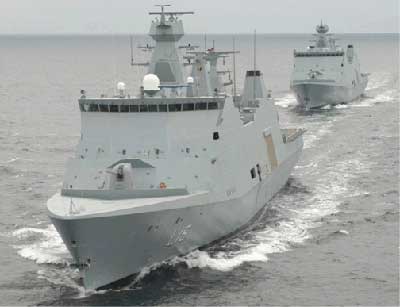
Such a vessel would broach some criticism as it would draw more water, but Absalon for instance carries 2 CB90s which can carry the fight into far shallower water than LCS (and with, say 2 NLOS packs could have almost the same armament).
For a variety of reasons put forth here I feel that most of the peacetime things that can be done adequately by a warship armed like the LCS can be more efficiently done by the US Coast Guard..however the cutters aren't going to have the support capability for minesweeping and such that the LCS designs do.
Now, it may be that the 50 kts speed and other less visible characteristics mean that one of the Litorral Combat ship designs is better suited to the subsidiary duties it is intended to do, but these duties don't include going into harms way and these vessels are not frigates by any measure. Referring to these interesting vessels as such officially threatens to displace real warships which the navy needs in addition to auxiliaries.
Posted by: The Brickmuppet at
12:56 AM
| Comments (4)
| Add Comment
Post contains 1341 words, total size 10 kb.
November 28, 2008
Posted by: The Brickmuppet at
06:17 AM
| Comments (6)
| Add Comment
Post contains 11 words, total size 1 kb.
September 28, 2008
The US Coast Guard has announced that it has finally settled on a patrol boat design to replace its aging 110 foot "Island Class" patrol boats. It appears that they have made a very good choice.
Behold! the Sentinel class, 153 foot patrol boats.
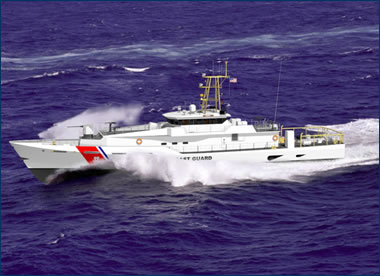
The vessel is robust, steel hulled, lightly ice strengthened and considered seaworthy enough that a version of these vessels was recently been put into service with the South African Coast Guard, where its patrol area includes the violent seas around Cape Agulhas and parts of the Southern Ocean. A version is also in service with the UK's customs service.
In other words...the design has been vetted!
NO SURPRISES THIS TIME!
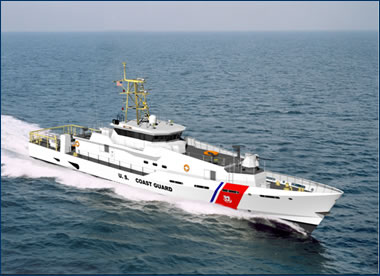
The vessel is quite heavily armed for a Coast Guard cutter with 4x.50 caliber machine guns and a 25mm chain gun. Stern launch systems are exceedingly convenient and safe, but because of their location and the need for a large hole in the structure, they have caused some structural issues and had teething problems.
However, this stern launching system is in service with both the closely related Dutch and UK versions of the design. Thus, it has been through its "learning experience" phase. Thus there should be minimal issues with it.
After the delays, disappointments and disasters involving procurement, this is a very heartening decision.
More here and here.
Posted by: The Brickmuppet at
05:41 AM
| Comments (4)
| Add Comment
Post contains 329 words, total size 3 kb.
September 22, 2008
Fire support is on the radar again as the Navy's solution to the problem seems to be in trouble.
The on again off again saga of the DDG1000 has hit another snag. The program has been cut to a tech demonstrator of two hulls, and then increased to 3 hulls, possibly for industrial capacity reasons.
Now there is apparently a nontrivial issue
with affixing the composite superstructure to the hull. This could
actually kill the program. Unless a better composite material can be
found, this could require a complete redesign of the vessel...which at
this point in the troubled program could well be a program ender.
First some background and explanation.

The DDG 1000 was conceived during the 90s as a fire support vessel
in part to replace the old battleships. It grew as new weapons systems
were added and became quite expensive. These ships are designed to take
a huge ammount of punishment and they have very robust scantlings and
thick shell plating...up to 20mm thick which is nearly as thick as the
unarmored sections of a battleship. There are also design features
associated with stealth that are giving some naval experts pause, such
as the sloped sides (tumblehome) They are designed around 2
experimental 155 mm guns and have 80 missile tubes. Its development
has been troubled to say the least, in no small part because virtually
every piece of equipment outside of the galley, laundry, rope locker
and the 2 Bofors guns is new and experimental..
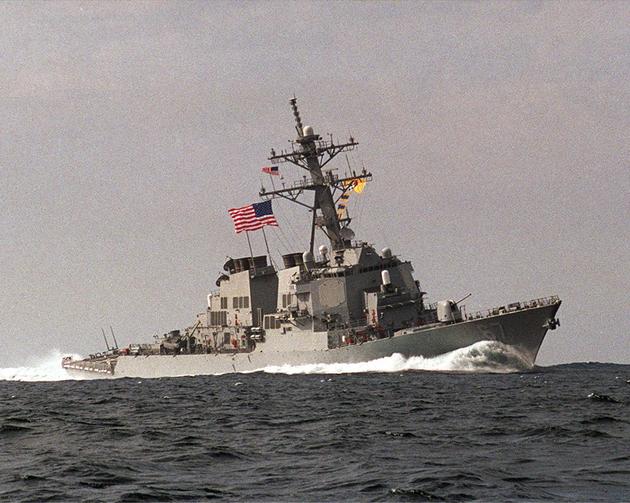
The ships referred to as Arleigh Burke class destroyers
are actually 3 similar classes of warship that are based on the same
basic design. The later ships have helicopter hangers for 2 Seahawk
helicopters which greatly enhances their peacetime potential and anti
submarine capability.
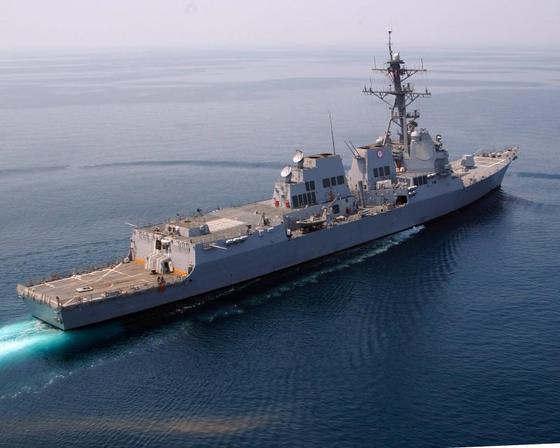
However, the latest ships omit some useful secondary systems as
an austerity measure. The vessels were rather long in development and
were designed at the height of the cold war to replace obsolete guided
missle destroyers designed in the 50s and 60s. They were intended as
carrier escorts and have a version of the AEGIS air defense system
which makes them extremely effective anti aircraft ships. They were
also designed with attention paid to toughness but they are still built
to destroyer standards. The vessels are designed around percieved cold
war needs, the gun was very much an afterthought as were the helicopter
araingements which are located right aft for maximum pitching in a
seaway. Their soft power projection ability is limited and they are
really expensive ships to be risking inshore. These vessels are well
liked and have a fine reputation for reliability, though expensive to
build and maintain they are, on a ton for ton basis fairly economical
when considering their firepower and targeting capability.
Keeping in mind the situation with the DDG 1000 program, Danger Room! reports that there is interest in fitting new 'Burkes with some additional kit like the AGS gun. This is problematic to say the least.
The Advanced Gun System is HUGE...Naval architects say it would
displace the forward VLS nest as well as the 5 inch gun, cutting the
ships missile capability by one third. It would mean a lot of weight
forward which is problematic for seakeeping and that much weight and
recoil would require design changes that a 3rd class enlisted Coastie
can't even begin to get his head around. The Danger Room! post also
notes that magazine capacity would be a miserable 120 rounds
The AGS Advanced Gun System
is a 155mm (6.1 inch) cannon intended to fire shells about 100 miles
away. Its a lot bigger and heavier than its medium caliber (a standard
caliber for NATO armies) would lead one to believe. This weapon, at
~100 tons, is as heavy as the main guns on some battleships! It fires
a shell that is actually heavier than most 8" shells from WW2. In the
1990s an 8 inch 60-62 caliber weapon was successfully tested , however
the 155mm shell diameter was chosen in part in anticipation of using
standard NATO ammunition for less demanding shots. This was mistaken as
the NATO shells can't actually be fired from the gun as developed.
(
Caliber in large guns generally refers to the length of the barrel
multiplied by the diameter so a 5 inch 54 caliber gun is 270 inches
long. Longer barrels can, in theory, achieve higher velocities. )
The Navy currently uses 2 types of medium sized guns, both 5 inchers. The old 5"54 caliber weapon developed in the 60s is supposed to be replaced with the 5"62 caliber gun. This can fire the old ammunition at a higher velocity and was intended to fire a new super long ranged guided round the EGRM as far as 60 miles but that has been canceled
by the current congress. The 5" guns are reliable but have limited
hitting power. They are probably adequate for most cases though.
At the lower end of the scale The USN and USCG have, since the 1970s used a license built version the old Italian OTO Melera 76mm (3inch)
gun for frigates and the larger Coast Guard cutters. This weapon is
reliable and very popular around the world but is no longer state of
the art. There are much more modern versions of it available.
Instead of going with those versions, the Navy, after a series of tests, decided on a 57mm gun originally developed in Sweden. It is a modernized version of a weapon that has given good service overseas for 40 years and fires twice as fast as the fastest 3" guns available. It is a better anti missile weapon and, surprisingly, has a longer range than the current 3"weapon.
This weapon is the 'main gun' on the Littoral Combat Ships. The 57mm weapon has some utility because, with a rate of fire of 4 rounds a second, its effect has been likened to a cluster bomb going off. However, its six pound shell is half as powerful as the 3 incher and neither is generally considered an adequate shore bombardment weapon. In fact the Brits determined in the 1960s that something in the vicinity of 105mm was the minimum as fire support needs to provide indirect fire...that is lobbing over hills and such.
So, if the AGS system is not going to go to sea any time soon, what might we do to give Uncle Sams Misguided Children fire support both on and off the beach?
This
does not just mean air strike or launching cruise missiles. This
requires being able to hit targets, possibly moving targets exactly
where the ground forces tell you. It means firing a lot of times (and
missiles are bulky) It also means giving close support and escort
landing craft, or (food convoys) all the way to the beach. Note that
the ground forces might not be Marines or Army but could be allied
forces in joint operations.
In the immediate term this is
going to involve sending very large expensive ships with large crews
inshore to shoot at bad guys with their 5 inch guns. If the targets are
in 5 inch gun range the ships are within the range of much
unpleasantness in the form of guns, missiles and torpedoes. This is a
suboptimal solution but its all we have.
In the near term, if the program is not nixed, we have the Littoral Combat ships. One option might be to fit a bigger gun than the 57mm, but these are lightly built vessels and it is unlikely they could take a 5" gun.
There is an interesting option however......and that is the French 100mm gun. (gasp!)

The export version is shown above on a Malaysian OPV. It is also used by China and a few other nations. It weighs 14 tons...which makes an interesting comparison with the 14 ton 57mm weapon already fitted.
That is not entirely true since the 14 tons only includes 114 rounds of ammo, a magazine and ancillary equipment brings its total to 18 tons, which is still quite close to the current weapon (and the additional weights would be low in the hull). The version the French use themselves has some whistles and bells (like local control) that bring it to 22 tons. Even this might still be doable with a slight redesign of subsequent versions of the LCS.
The French arrived at this weapon after considerable testing. It is intended to be light enough for effective AAA fire and fire a heavy enough shell for shore bombardment. Indeed, it was intended as the main weapon of French Avisos (colonial gunboats) and incorporated the fire support lessons of the Indochina War. The shells are about 30 pounds and while less than half the weight of the 5" weapon these have a better chance of taking out a pillbox or a tank than the 57mm gun. The AAA rounds proximity fuse can likely ruin an infantry platoons whole day. The weapon is already developed, highly regarded and the gun and ammunition is in use with several nations, including Argentina, Brazil and Uruguay in the Americas. It could meaningfully upgrade the capability of the LCS in surface combat.
18 tons-22 tons is pretty light, this weapon could be fitted to fairly small vessels (It is used on 1300 ton OPVs ) that would be built in greater numbers.
On the debit side the weapon uses nonstandard ammunition and parts.
To get around that there is the possibility of marinizing a 105mm artillery piece such as that used in the Striker MGS or the Buford light tank.
This
would have the advantage from the defense procurement officials
standpoint of expending lots of unnecessary money and time to achieve
almost the same results as buying an off the shelf weapon....but
without any AAA capability. On the other hand using standard NATO 105mm
ammunition could be advantageous and such a system might be very light
indeed both of which might discourage this approach. (What...ME cynical?)
There is a discussion of this here where Tony Williams notes a UK project along these lines involving a tank turret that weighed 6 tons!?.....damn...put two of them on a Cyclone
or similar small ship! There are likely to be issues with this approach
but it is an interesting idea nonetheless. 6 tons puts it in the
capability of some VERY small craft.
Of course one of the
complaints about fire support is that the current weapons are too
small, and going with a gun that is half as powerful does not address
that. To that end the UK is developing a marinized version of its 155mm artilery piece.
Intended to fit in the same turret as a standard Royal Navy 4.5 inch
gun the weapon or something like it would be a good replacement for the
5 inch guns on USN cruisers and destroyers giving considerably more
hitting power and perhaps even an increase in range now that the EGRM
round has been canceled. Whether this is worthwhile is debatable.
On a tangent...The old Cruisers of the Ticonderoga class were actually strengthened and had space reserved to take an 8 inch gun that was developed in the 70s, though its unclear if...1: we could build those guns now or 2: if they could still take these weapons after their many upgrades. If it could be produced, it could certainly be fitted to specially designed new build ships of modest size.....as it was a successful weapon and the tests were actually conducted from an old (2800 ton) Forrest Sherman Class destroyer.
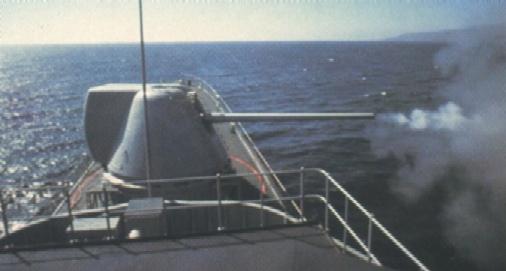
Guns are the most economical in space but missiles can be useful too. For really heavy artillery the Army's GMLRS rockets
are quite impressive, carrying a precision guided 200 pound warhead 40
miles away. The warhead on this 9" diameter rocket is bigger than the
bursting charge of a 16" shell. These can't be fired from warships for
a variety of reasons, however in 1999 Lockmart proposed POLAR, The
Precision Over the horizon Land Attack Rocket which is mentioned
briefly here
used a marinized and lengthened version of the same weapon that could
be packed 4 per cell in a vertical launch tube and would have had a
range of over 100 miles. Hitting nearly as hard as a battleship gun
from 5 times the distance and with precision guidance and
being relatively cheap this weapon would have solved the heavy fire
support problem at a stroke, but was canceled. It could probably be
revived without too much trouble Many of these options have been
looked at before and were rejected in favor of the AGS which, being a
battleship sized weapon, requires a ship as big as a predreadnaught to
carry it with any efficiency.
Posted by: The Brickmuppet at
09:40 PM
| No Comments
| Add Comment
Post contains 2158 words, total size 16 kb.
July 26, 2008
Gahlran (who does not use random catgirls and 'science babes' to lighten the mood of his blog) has a typically thorough and thoughtful post on the strategic direction of the navy and what should be its corresponding shipbuilding program. He is particularly concerned that the Navy does not have enough small combatants for short of war duties. Read the whole thing.
Rather unusually, I disagree, particularly with this statement from the post.
...Indeed if you look at activities like that of the Coast Guard cutter Dallas (WHEC 716), the Navy is basically outsourcing its peacetime engagement responsibilities in major maritime theaters to the already stretched thin Coast Guard. The Navy really should be embarrassed that it is incapable of doing the mission the Coast Guard does today in the Persian Gulf, it is a tragedy of leadership the Navy doesn't see its inability to do that mission as a problem, because that is part of the global mission set the maritime domain demands in today's maritime era....
First of all...GO COAST GUARD!
As to the idea that the Navy should be ashamed that the USCG is conducting these missions...
No.
The Navy should be damned proud that, unlike some loons, it is a professional enough organization to be actively partnering with its fellow sea service. This enables that organizations strengths to be utilized while avoiding the dilution of its own.
The USCG has a surprising number of specific strengths in the international arena. These include working closely, and generally benignly, with the worlds merchant fleets, fishing fleets, the UN (particularly through the IMO) and anyone who is in the water and doesn't want to be. Because the USCG has as one of its main Raison' Detre's the rescue of mariners, so they are always welcome sights in foreign harbors, particularly since their peacetime armament is generally no more intimidating than a light gun and, perhaps, a CIWS.
Trained to operate in close proximity and cooperation with the public, Coasties are a good choice for diplomatic presence missions. There is a good body of expertise in boardings and maritime law enforcement operations. Coasties are adept at inshore work. Coasties also have small vessels with small crews that will minimize the loss of blood and treasure in the event of a successful asymmetrical attack.
This is not to suggest that the USCG take the whole of the show the flag mission from the USN. That would be silly, the USCG can perform some functions to compliment the Navy, particularly if the old ocean station program were revived...with different station locations. An earlier post on that is here.
The Navy has strengths too, such as amphibious warfare vessels that can be used to haul tremendous amounts of "stuff" to wherever the hell it is needed. Said "stuff " can be tanks, leathernecks, solar stills or food for disaster victims, small patrol boats, helicopters for a myriad of functions from assault to minesweeping to SAR, supplies....and baby screech owls.
The NAVY has yet more strengths, an airforce of brownshoes and leathernecks who care, really care, from the 4 stars on down, about close air support for those who need it. The Navy has the ability to strike targets ridiculously far inland, with missiles, bombs, and food packets. It has escorts for its carriers ( and, presumably civilian convoys as well) that can knock planes and missiles and even a friccking satellite out of their sky and will, if the program is not terminated, be able to defend ships and some land targets against incoming tactical ballistic missiles. Most of all the Navy is the 800 pound gorilla of the worlds oceans, they train and equip themselves to secure the sea lanes for the use of us and our allies. They do this with large ships that can carry the necessary electronics, and weapons, use said assets in the most violent sea states, and enough fuel to take this capability halfway around the world.
The Navy IS actually building a class of small combatants, the Littoral Combat Ships. These are interesting vessels but they are basically high performance utility craft. They have the fixed armament of a Coast Guard cutter but they seem intended to mainly act as tenders for unmanned vehicles that will provide a lot of functions such as mine warfare which is something the Navy has a definite need for. There are a lot of questions about this vessel that laymen are asking....particularly its cost and seemingly unnecessarily high speed.
However, those of us in the 82nd chairborne division don't know what specific tactical purpose the speed is supposed to support, it may be an operational requirement for drift and dash ASW, it could, given the large cargo area be related to seabasing or something else tied to a warm or hot war situation. The speed may not in fact be due to an admiral saying "Gee whiz! wouldn't 40 kts be swell!?"
For antipiracy, peacebuilding or short of war duties the vessels seem excessive, but that is likely a small portion of what they are designed to do.
Now Gahlran is right that a big concern is indeed the dwindling numbers of navy ships. No matter how capable a ship is it can only be in one place at once. This is less true for carriers but it is still true.
Some economy and increase in numbers can be made while maintaining hot war capability, the Australians very sensible choice of the Spanish F-100 is a good example of this. The best form of armor is to have another ship. The Australians were able to afford a 5th ship as opposed to the 4 cut down 'Burkes they were offered...but that can only go so far. The F-100 has half the missile tubes in addition to the attendant disadvantages of a smaller hull ...for 60-80% the cost.
Additionally, inshore, in most locations, a 4,500 ton ship is not going to be able to go a lot of places the 9,000 Burke can't. That kind of maneuverability really doesn't come until you get rather smaller, like under 200 feet in length and ~ 600 tons....a, um, Coast Guard patrol boat....or for extreme inshore fighting...a CB90.
There is a political dimension as well. If the nation develops very austere vessels...."peace cruisers" in the parlance of the old navy....these vessels will be counted by congresscritters as hulls on the navy list...to the potential detriment of the hot war fighting capability of the navy.
There is a temptation on the part of many to point out that the current unlikelihood of a war with a peer force is going to hold for a very long time. It won't and greatly reducing our emphasis on that currently unlikely scenario ironically makes it more likely.
The criticism of "next war-itis" is not without merit as it is imperative to focus on the war you are fighting now.
However, this does not hold quite as true for the Navy. One of the reasons that there is no peer competitor right now, is because those that might be dont see challenging us as in any way attainable except in specific circumstances (cough Taiwan straits cough). If we detract from the carrier strike capability and the escorts that protect it we open a window that a competitor might use to build a fleet quite rapidly. The problems our shipbuilding industry has are severe and the topic of another post, but suffice it to say we would be hard pressed to do any dramatic surge in shipbuilding.
The biggest problem the navy has is a lack of support vessels...oilers and other logistics vessels. This needs attention.
Galhran has raised some good points, particularly with regards to the basically capital ship status of submarines and the idea of using austere, perhaps off the shelf amphibious vessels as presence ships ( about which more here). However, reorienting the navy away from a Mahanian force to a gunboat navy is in my opinion a poor bargain and a strategic misstep.
Posted by: The Brickmuppet at
04:34 PM
| Comments (1)
| Add Comment
Post contains 1440 words, total size 11 kb.
79 queries taking 0.4025 seconds, 276 records returned.
Powered by Minx 1.1.6c-pink.








